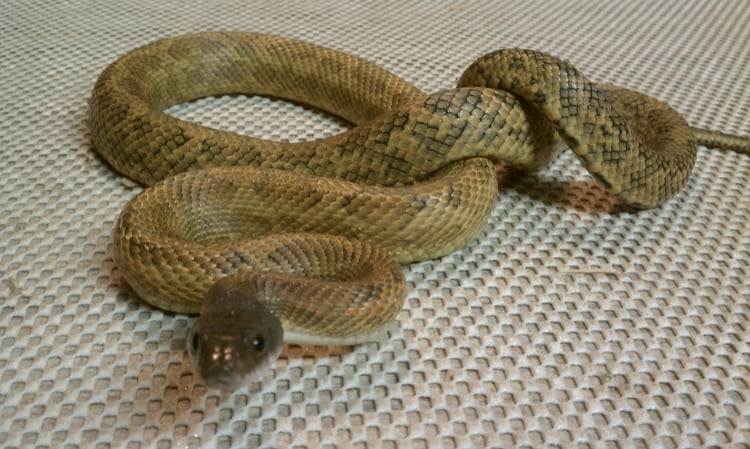About this Morph
I have been observing the snakes in my rural NE Texas area since the mid 1980’s but I never thought to keep or breed any reptiles until 2002 when I found myself with a lot of free time on my hands and a big, empty, house way out in the country.
After a couple of years I was well versed in raising and breeding all types of popular “pet-trade” snakes but I was also tired of spending all my free time cleaning cages for my "collection". I decided that what I wanted to do was pick a long term project that got me out into the field as much as possible.
This led to my decision to work with one of the most prevalent snakes in my area: the Texas Rat Snake (Pantherophis obsoletus lindheimeri) . They are hearty, easy to feed, easy to breed, and active. (They are also often nippy, irritable, and not very nice) I wanted to apply what I had learned about colubrid husbandry and get to play with the age old art of selective breeding.
The Texas Rat Snake is such a common snake in my area that I had previously paid it no attention. There was no novelty in finding or catching one. However, it just so happens that back in 2002 when i was getting started I walked up to a table at a herp show and saw my first ever “yellow phase” Texas Rat Snakes. (Where I live East of Dallas all the Texas rat snakes have very dark ground color). The man who had these snakes was an experienced breeder who had an extensive knowledge of Texas snakes and more than a few interesting animals. In particular he had a pair of Texas rat snakes with what I thought was exceptional yellow coloration. He assured me they were typical for their region but he had one hatchling which he said was “quite unusual” It was noticeably lighter in color than the parents and the tongue was a weird pink color instead of bright red. I bought this male snake from him and set out to find a suitable wild caught female from my locality to breed to him. (I sold this male when he was 13 years old and he was pumpkin orange pictured below.)
Quick note about field herping and wild caught animals:
There is an ethical problem to face when you go decide to remove animals from their habitat: it affects the animals and their habitat!
That being said, I did it as legally and ethically as possible. (that's an argument for another thread)
For the purposes of this project I knew that I would be picking up things that I didn’t put right back down. It’s because of this, I got my first Texas (non-commercial) non-game permit. I renew it every year with my fishing and hunting license, even though I don't need it. There's also a story about how the non-game laws changed around this time but that's also for another thread. In the case of breeding my Texas rat snakes, I took some specimens home in bags to sort and inspect. Every snake not found suitable was returned to where they were caught within a few days. I also kept a rather intense spreadsheet for the animals I did keep. This is how I am able to sort this morph out now.
She laid 24 eggs, all hatched and I found myself with the problem of deciding which of these black & grey babies was unique. I picked a few based on their lack of contrast and broken spotting. I do not have any decent pictures of the 2010 hatchlings but this pictures of some of the 2017 hatchlings should serve as an example. (click here for "how to tell a hatchling cadmium morph")
~¼ of the babies (5 out of 16) came out hypo-melanistic with noticeable broken patterns. This should indicate that it’s recessive in both parents but I did not raise all 16 snakes to prove this. In 2010 I hatched more from the same brother/sister pairing. Once again ¼ of the babies gave me weird spotting and washed out patterns. I kept the best male and female from that group. I repeated this process for a few more years until I once again had way too many snakes to take care of. Lets take a look at a few of them now:
Below is the 2010 male:
Below is the 2010 female:
Below is a 2012 male
Below is a 2013 male
Below is a 2015 male
Below is a 2015 female
Below is a 2016 female
and here's a 2017 hatching! (just for fun)
So now I have this room filled with rat snakes again and a family tree beginning to emerge.
In 2015 I sold some snakes and decided to get serious about breeding for a couple years so I could document these snakes. In 2016 I did a very bad job of it. But I stuck with it and my blog is full of color comparisons every 3 or 4 months as the babies matured. In 2017 I revised my feeding/breeding schedule and got serious about mapping out the genetic line. I had great success with lots of pairings and got lots of healthy babies. (I also learned how to take better pictures) I am currently getting rid of all my adult hets and will work with nothing but my morph for a couple years. I am also charting temperament for the animals I am breeding as some of them are pussy cats while others are tigers.
I encourage you to read through my blog if you want to know more (it's almost all pictures).
Finally, I am calling this morph “cadmium” because they encompass the same spectrum of colors as cadmium. Also, because I refuse to name an animal synonymous with the spread of Salmonella after food. :)













